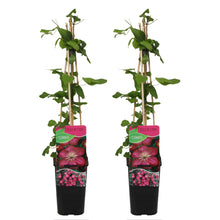Clematis 'Ville de Lyon' is a vigorous and free-flowering Clematis cultivar, admired for its vibrant, carmine-red flowers and long blooming season. This deciduous climber produces a profusion of large, velvety, reddish-pink flowers with a prominent cluster of yellow stamens in the center. The blooms typically have six to eight overlapping petals and fade to a richer crimson as they mature, creating a bold and captivating display. It's a popular choice for trellises, arbors, fences, and walls, adding a splash of vibrant colour to gardens and landscapes. It belongs to the Ranunculaceae family.
Origin: Clematis 'Ville de Lyon' was bred by the French breeder, Francisque Morel, in 1899. It is named after the city of Lyon in France.
Light: Clematis 'Ville de Lyon' thrives in full sun to partial shade. It prefers a location with at least 6 hours of sunlight per day to encourage optimal growth and flowering, but it can tolerate some shade, especially in hotter climates.
Water: Consistent watering is important, especially during dry periods and in the first year after planting. This Clematis prefers consistently moist soil that is also well-drained. Avoid overwatering, which can lead to root rot.
Soil: Clematis 'Ville de Lyon' prefers fertile, well-drained soil. It thrives in loamy soil with a slightly alkaline to neutral pH.
Support: As a climbing vine, Clematis 'Ville de Lyon' needs support to grow. Provide a trellis, fence, or other structure for it to climb on.
Pruning: This Clematis falls into pruning group 3, meaning it flowers on new wood. Prune hard in late winter or early spring, cutting back the previous year's growth to about 30cm (12 inches) from the ground. This will encourage vigorous new growth and abundant flowering.
Pests and Diseases: Be vigilant for common Clematis pests and diseases, such as slugs, snails, aphids, and Clematis wilt.
Uses: Clematis 'Ville de Lyon' is primarily grown as an ornamental vine for its vibrant and showy flowers. It's a popular choice for trellises, arbors, fences, and walls, adding a splash of colour to gardens and landscapes.
Toxicity: Clematis can be mildly toxic to humans and pets if ingested, causing mouth irritation and stomach upset.



